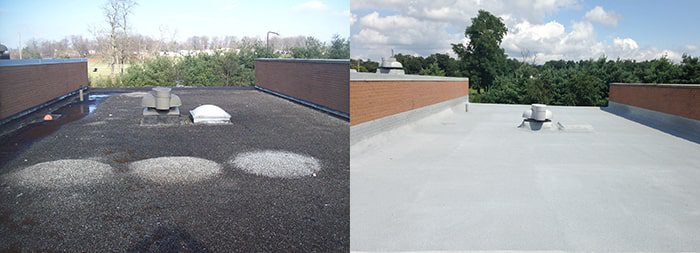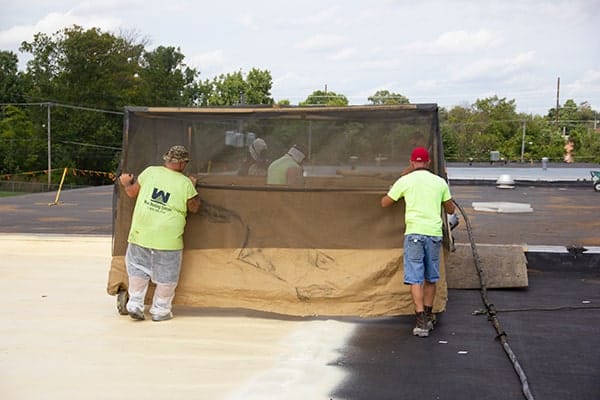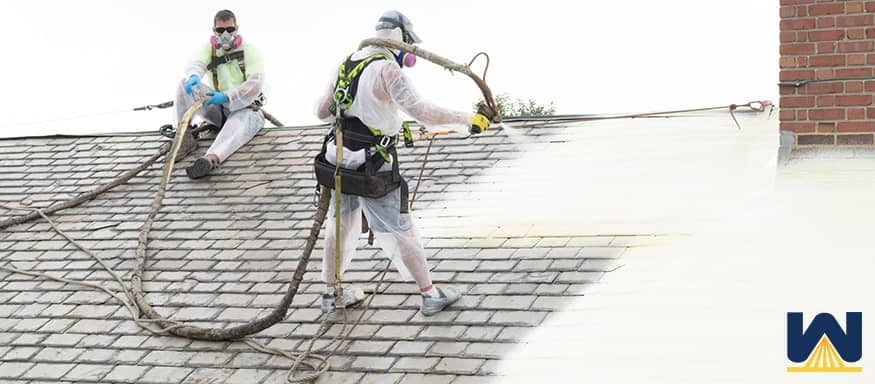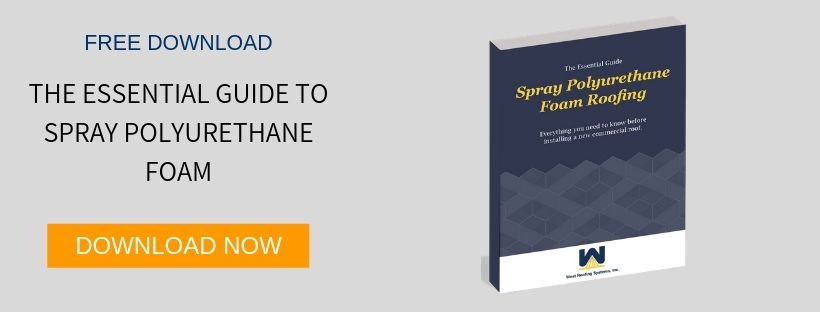If you were a building owner, wouldn’t you be concerned with a roofing contractor mixing and heating chemicals near your building?
Also, wouldn’t you like to know if spray foam that surrounds your building is safe for your employees to breathe?
And then lastly, wouldn’t you like to know if spray foam is good for the environment?
Common sales questions we often hear are
- Is spray foam safe for the environment?
- Is spray foam safe to apply?
In this article we’ll go through spray polyurethane foam for roofing purposes and describe its safety during application and for the environment.
Let’s begin…
By now you probably know that spray polyurethane foam roofs looks great, and if you’re looking at lifetime cost, it can be the last roof you ever have to put on your building.

But let’s look at nine safety issues owners are concerned with regarding spray foam roofing.
9 questions building owners ask about spray foam safety:
1. Do I need to shut my building down to install spray foam roofing?
Not at all. As far as safety-wise, a responsible roofing contractor will protect the intakes on a building. The units they are working around, they will wrap them or shut them down so that no fumes will get inside the building.
Side note: Spraying foam is faster than other roofing systems so it’s less time on your roof. There’s no need for shutdown. There’s no business interruption.
2. Will my employees need to park elsewhere?
We have a box truck, a stake side and a pickup truck that’s going to be at every job site. The only thing that must be by the building is the box truck. We have parked hundreds of feet away because we have several hundred feet of hose, so depending on the circumstances, we can usually make parking work without any issues to the building owner.
We only need a couple parking spots if we’re spraying foam over your existing roof. We would need a few more if tear off is needed to accommodate a crane and dumpster.
3. Will there be breathing issues for building workers during SPF application?
Industry standard, when spraying foam, you need to use a respirator when you’re within 15 feet of spray foam for a duration of 5 minutes.
At no time does the public ever get that close to the spray.
We’ve never had a complaint about over spraying the public while on a roof.
4. Are there any safety issues with a heating of materials near a building?
A roofing contractor will use band heaters that are designed to heat the drums.
There are no open flames in the back of trucks whatsoever and there’s nothing in the truck that’s flammable.
There are no issues with safety to the building owner in this scenario.
5. How long will my HVAC units be shut off?
If we can spray without turning them off, we won’t turn them off. The majority (85-90%) of the time, there is no need to turn them off.
Unless a building has a giant air source (like a 40 foot long HVAC unit), we typically don’t need to shut down air intakes. A roofing contractor should always talk with the building owner to see what intake source they have.
At West Roofing, we’ve had instances where we were spraying on a roof, but on the building over, there was a newer HVAC unit installed that the owner was afraid of over spray.
The building owner expressed that shutting the HVAC unit down is not an option.
We built charcoal filters that were placed in front of the unit and the unit itself was wrapped in burlap.
Because of his concern, we adjusted the application to protect what the owner wanted protected.
6. Will any lasting smells from the application go through the building?
None.
During spray foam application, the HVAC units are turned off, or protected, so no spray foam enters the building.
When silicone coating is sprayed over top spray foam, that silicone is made with “high-solids”, so there is very, very little solvent.
Solvents are the reason there’s a foul smell with silicone application, but with the elimination of solvent, there is no lasting smell.
7. Is there any potential for spray foam over spray?
A building owner wants to find a roofing contractor that sprays foam for a living. Not a guy that has a crew that does it. The reason they want to use an experienced crew is because all the nightmares you find on Google on interior foam jobs.
There’s a lot of people that will tell you spray foam ruined their house. And that’s because they don’t know how to spray on ratio. If someone knows what they are doing and sprays foam on ratio, you’re never going to have an odor issue.
The biggest safety issue a building owner is worried about is the potential for overspray.
We use car covers, and in one instance, we mounted burlap on a wall to protect the whole roof from overspray.
If there’s too many cars to cover, we’ll use a booth to make sure no spray is coming out of that booth. Even if we use a robot to spray, we put the robot in the booth to ensure no spray will come out.

We’ve gone to places where we cannot have any over spray period (like an airport), and we handle the situation accordingly.
Now let’s get into spray foam safety and the environment
Is spray polyurethane foam that’s used for roofing safe for the environment?
We can look at this in two ways:
- The materials used in spraying down foam
- The waste created during its lifetime
8. What materials have been phasing out to make spray foam?
Since 1979 (the year we began spraying down foam), the blowing agents used to create foam have changed multiple times. This is due to materials being phased out for having a high level of ozone depleting potential (ODP).
Examples of materials that have been phased out include:
- CFC (chlorofluorocarbons) – phasing out CFCs led to HCFCs
- HCFC (hydro-chlorofluorocarbons) – phasing out HCFCs led to HFCs
- HFC (hydrofluorocarbons) – there is a set target of the year 2020 to replace HFCs with HFOs (hydrofluoro-Olefins)
Manufacturers of spray foam materials need to be aware of the Montreal Protocol as products containing certain chemicals get phased out.
The bottom line is that the phasing out of materials has kept the spray foam industry and the products used safe to the environment.
The materials that are used for SPF roofing systems are environmentally friendly by having:
- Zero Ozone Depleting Potential (ODP)
- Low in the Emission of Volatile Organic Compounds (VOCS)
- Free from Chlorofluorocarbons (CFCS)
- Ultra-Low Global Warming Potential (GWP)
9. With spray foam roofs having little to no waste, is that good for the environment?
In most cases, there’s minimal stripping of the original roof, and the spray foam roof is installed on top, eliminating the need for costly roof tear-offs and waste.
The less tear off that goes into your roofing project, the more cost-effective (and environmentally-friendly) it’ll be.
Tear off isn’t environmentally-friendly because your old roofing materials will contribute to already overly burdened landfills.
The only areas that need torn off are wet areas, which are identified at the beginning of a roofing project with an infrared survey.
During a spray foam roofs’ lifetime, there’s also no tear-off. When tiny incisions are made, all you need to do is fill the incision with caulk/sealant and the roof is back to performing how it should.
Conclusion about spray foam and the environment
Hopefully today you learned something new about spray polyurethane foam and safety issues.
If you’re looking for a long-lasting, economically efficient option, a spray foam roof is the way to go.
Need to learn more about spray polyurethane foam? Below is a free download where you’ll learn:
- how much spray foam roofing costs?
- how does spray foam compare to other roofing solutions?
- common problems spray foam roofs have


